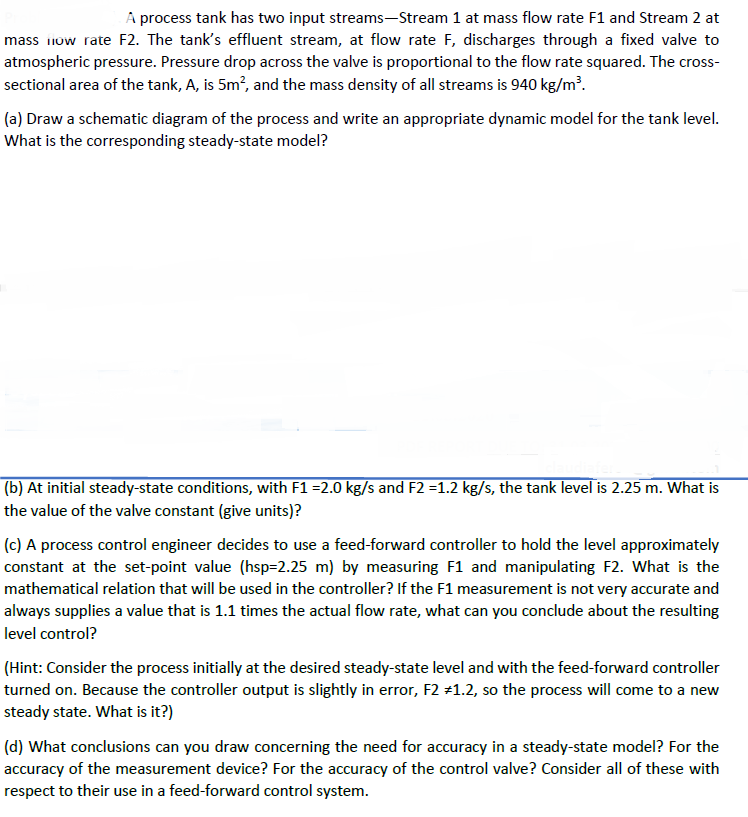A process tank has two input streams-Stream 1 at mass flow rate F1 and Stream 2 at mass 1iow rate F2. The tank's effluent stream, at flow rate F, discharges through a fixed valve to atmospheric pressure. Pressure drop across the valve is proportional to the flow rate squared. The cross- sectional area of the tank, A, is 5m?, and the mass density of all streams is 940 kg/m². (a) Draw a schematic diagram of the process and write an appropriate dynamic model for the tank level. What is the corresponding steady-state model? (b) At initial steady-state conditions, with F1 =2.0 kg/s and F2 =1.2 kg/s, the tank level is 2.25 m. What is the value of the valve constant (give units)? (c) A process control engineer decides to use a feed-forward controller to hold the level approximately constant at the set-point value (hsp=2.25 m) by measuring F1 and manipulating F2. What is the mathematical relation that will be used in the controller? If the F1 measurement is not very accurate and always supplies a value that is 1.1 times the actual flow rate, what can you conclude about the resulting level control? (Hint: Consider the process initially at the desired steady-state level and with the feed-forward controller turned on. Because the controller output is slightly in error, F2 +1.2, so the process will come to a new steady state. What is it?) (d) What conclusions can you draw concerning the need for accuracy in a steady-state model? For the accuracy of the measurement device? For the accuracy of the control valve? Consider all of these with respect to their use in a feed-forward control system.
A process tank has two input streams-Stream 1 at mass flow rate F1 and Stream 2 at mass 1iow rate F2. The tank's effluent stream, at flow rate F, discharges through a fixed valve to atmospheric pressure. Pressure drop across the valve is proportional to the flow rate squared. The cross- sectional area of the tank, A, is 5m?, and the mass density of all streams is 940 kg/m². (a) Draw a schematic diagram of the process and write an appropriate dynamic model for the tank level. What is the corresponding steady-state model? (b) At initial steady-state conditions, with F1 =2.0 kg/s and F2 =1.2 kg/s, the tank level is 2.25 m. What is the value of the valve constant (give units)? (c) A process control engineer decides to use a feed-forward controller to hold the level approximately constant at the set-point value (hsp=2.25 m) by measuring F1 and manipulating F2. What is the mathematical relation that will be used in the controller? If the F1 measurement is not very accurate and always supplies a value that is 1.1 times the actual flow rate, what can you conclude about the resulting level control? (Hint: Consider the process initially at the desired steady-state level and with the feed-forward controller turned on. Because the controller output is slightly in error, F2 +1.2, so the process will come to a new steady state. What is it?) (d) What conclusions can you draw concerning the need for accuracy in a steady-state model? For the accuracy of the measurement device? For the accuracy of the control valve? Consider all of these with respect to their use in a feed-forward control system.
Principles of Heat Transfer (Activate Learning with these NEW titles from Engineering!)
8th Edition
ISBN:9781305387102
Author:Kreith, Frank; Manglik, Raj M.
Publisher:Kreith, Frank; Manglik, Raj M.
Chapter5: Analysis Of Convection Heat Transfer
Section: Chapter Questions
Problem 5.32P
Related questions
Question

Transcribed Image Text:A process tank has two input streams-Stream 1 at mass flow rate F1 and Stream 2 at
mass 1now rate F2. The tank's effluent stream, at flow rate F, discharges through a fixed valve to
atmospheric pressure. Pressure drop across the valve is proportional to the flow rate squared. The cross-
sectional area of the tank, A, is 5m?, and the mass density of all streams is 940 kg/m³.
(a) Draw a schematic diagram of the process and write an appropriate dynamic model for the tank level.
What is the corresponding steady-state model?
(b) At initial steady-state conditions, with F1 =2.0 kg/s and F2 =1.2 kg/s, the tank level is 2.25 m. What is
the value of the valve constant (give units)?
(c) A process control engineer decides to use a feed-forward controller to hold the level approximately
constant at the set-point value (hsp=2.25 m) by measuring F1 and manipulating F2. What is the
mathematical relation that will be used in the controller? If the F1 measurement is not very accurate and
always supplies a value that is 1.1 times the actual flow rate, what can you conclude about the resulting
level control?
(Hint: Consider the process initially at the desired steady-state level and with the feed-forward controller
turned on. Because the controller output is slightly in error, F2 +1.2, so the process will come to a new
steady state. What is it?)
(d) What conclusions can you draw concerning the need for accuracy in a steady-state model? For the
accuracy of the measurement device? For the accuracy of the control valve? Consider all of these with
respect to their use in a feed-forward control system.
Expert Solution
This question has been solved!
Explore an expertly crafted, step-by-step solution for a thorough understanding of key concepts.
This is a popular solution!
Trending now
This is a popular solution!
Step by step
Solved in 4 steps with 4 images

Knowledge Booster
Learn more about
Need a deep-dive on the concept behind this application? Look no further. Learn more about this topic, mechanical-engineering and related others by exploring similar questions and additional content below.Recommended textbooks for you

Principles of Heat Transfer (Activate Learning wi…
Mechanical Engineering
ISBN:
9781305387102
Author:
Kreith, Frank; Manglik, Raj M.
Publisher:
Cengage Learning

Principles of Heat Transfer (Activate Learning wi…
Mechanical Engineering
ISBN:
9781305387102
Author:
Kreith, Frank; Manglik, Raj M.
Publisher:
Cengage Learning